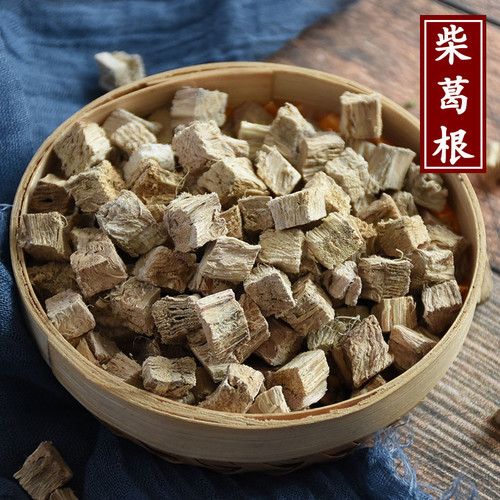Product Overview
Parts used: Dried root
TCM category: Cool/Acrid herbs that release the Exterior
TCM nature: Cool
TCM taste(s): PungentSweet
Meridian affinity: Spleen Stomach
Scientific name: Pueraria thomsonii
Other names: Japanese arrowroot, East Asian arrowroot, Arrowroot
Use of kudzu roots (Ge Gen) in TCM
Please note that you should never self-prescribe TCM ingredients. A TCM ingredient is almost never eaten on its own but as part of a formula containing several ingredients that act together. Please consult a professional TCM practitionner, they will be best able to guide you.
Preparation: Remove impurities, wash, soak in water, cut in thick slices and dry.
Dosage: 9-15g
Main actions according to TCM*: Relieves muscle tension especially in the neck and shoulders. Relieves the Exterior and scatters Wind. Supports the Fluids and eases thirst. Assists in the expression of measles. Relieves diarrhea. Relieves hypertension.
Primary conditions or symptoms for which kudzu roots may be prescribed by TCM doctors*: Fever Headache Diabetes Alcoholism Dysentery Diarrhea Measles Back pain High blood pressure Hypertension
Contraindications*: Should not be used by those with Cold in the Stomach and excessive sweating.
Common TCM formulas in which kudzu roots are used*:
For External, Wind-Cold conditions as well as tension and spasms of the upper back and neck combine kudzu roots with ephedra (Ma Huang), cinnamon twigs (Gui Zhi) and white peony roots (Bai Shao).
For measles and rashes combine kudzu roots with greater burdock fruits (Niu Bang Zi), bugbane rhizomes (Sheng Ma) and wild mint (Bo He).
Key TCM concepts behind kudzu roots (Ge Gen)'s properties
In Traditional Chinese Medicine (TCM), kudzu roots are plants that belong to the 'Cool/Acrid herbs that release the Exterior' category. Herbs that release the Exterior aim to to treat the early stages of diseases that affect the upper respiratory tract, the eyes, the ears, the nose, the throat or the skin. TCM believes that External diseases such as colds or allergies can only invade the body if the External environment overwhelms our Wei Qi (the TCM version of the immune system). In order to counteract this invasion Cool/Acrid herbs aim to induce sweating by dilating our capillary pores so that they release more sweat. The belief is that this will expel the disease from the body and stop it from invading further.
As suggested by its category kudzu roots are plants that are Cool in nature. This means that kudzu roots tend to help people who have too much "heat" in their body, although with less effect than a plant that would be Cold in nature. Balance between Yin and Yang is a key health concept in TCM. Those who have too much heat in their body are said to either have a Yang excess (because Yang is Hot in nature) or a Yin deficiency (Yin is Cold in Nature). Depending on your condition kudzu roots can help restore a harmonious balance between Yin and Yang.
Kudzu roots also taste Pungent and Sweet. The so-called "five elements" theory in Chinese Medicine states that the taste of TCM ingredients is a key determinant of their action in the body. Pungent ingredients like kudzu roots tend to promote the circulations of Qi and body fluids. That's why for instance someone tends to sweat a lot when they eat spicy/pungent food. On the other hand Sweet ingredients tend to slow down acute reactions and detoxify the body. They also have a tonic effect because they replenish Qi and Blood.
The tastes of ingredients in TCM also determine what organs and meridians they target. As such kudzu roots are thought to target the Spleen and the Stomach. In TCM the Spleen assists with digestion, blood coagulation and fluid metabolism in the body. The Stomach on the other hand is responsible for receiving and ripening ingested food and fluids. It is also tasked with descending the digested elements downwards to the Small Intestine.
Use of kudzu roots (Ge Gen) as food
Kudzu roots are also eaten as food. It is used as an ingredient in dishes such as Deep Fried Kudzu Tofu or Stuffed Kudzu Leaves.








